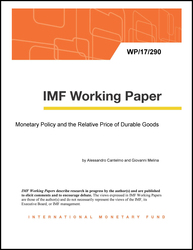
Monetary Policy and the Relative Price of Durable Goods
In a SVAR model of the US, the response of the relative price of durables to a monetary contraction is either flat or mildly positive. It significantly falls only if narrowly defined as the ratio between new-house and nondurables prices. These findings are rationalized via the estimation of a two-sector New-Keynesian (NK) models. Durables prices are estimated to be as sticky as nondurables, leading to a flat relative price response to a monetary shock. Conversely, house prices are estimated to be almost flexible. Such results survive several robustness checks and a three-sector extension of the NK model. These findings have implications for building two-sector NK models with durable and nondurable goods, and for the conduct of monetary policy.
Publication date: December 2017
ISBN: 9781484335451
$18.00
Add to Cart by clicking price of the language and format you'd like to purchase
Available Languages and Formats
| English |
Prices in red indicate formats that are not yet available but are forthcoming.
Topics covered in this book
This title contains information about the following subjects.
Click on a subject if you would like to see other titles with the same subjects.
durables , nondurables , price stickiness , relative price , Monetary Policy (Targets , Instruments , and Effects)
Summary
Copyright © 2010 - 2024
Powered by:
AIDC



